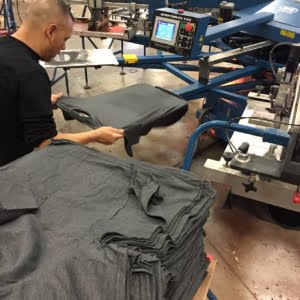A few years ago, someone slipped on a wet concrete floor at the shop and one of the other staff members inadvertently laughed. I guess it was just that type of pratfall that induced the giggle, but it clearly defined the lack of concern with the safety and well-being for that individual. The management staff took it very seriously, and after an investigation, disciplined the giggling employee. I wanted to include that incident as the introduction for this article, as it proved to me at the time that the safety culture that I thought we had at the shop, was severely lacking. Sure, as senior management we had all the correct tools and procedures, but didn’t take it one step further and talk about safety and demonstrate the seriousness of it to the staff. After that incident, we ramped up our efforts even further. I’ve traveled the country touring shops and engaging other company’s staff, and I’m always surprised that safety is one of the most overlooked aspects of running a shop.
Building a culture of safety at your shop is the one thing that you can do to proactively prevent a huge money drain from your bottom line. How many shirts would you need to print or embroider to make up the cash lost from a settlement or legal fees? If you don’t have a safety program, you should start today and build one. If you do, spend a few moments of good solid introspection and investigate to see if your actions not only prevent accidents, but would form a solid defense if you were inspected or subpoenaed. Listed below are some tips and ideas on building a proactive safety program:
Safety Committee. It all starts with this group. Form your committee with disparate members of your staff. I recommend using your HR Manager, someone from Accounting, a Production Manager, and at least one Line Employee, as the basis for the committee as you want to get different viewpoints and levels of involvement. This group’s goal is going to be to develop a Comprehensive Safety Plan for the company that includes written policies and procedures, training, inspections, facility management, the Emergency Action Plan, and the overall company documentation effort. Get a 3” three ring binder and start a Safety Notebook. Tab off sections and document everything regarding the safety program within this notebook. The Safety Committee should write, implement and enforce the company Safety Training. Task oriented training is critical, but every employee should receive a “Basic” training package that includes instruction on MSDS sheets, the Emergency Action Plan, Lock-Out / Tag-Out, accident prevention and reporting, and simple things such as lifting a box properly. Ideally this training should occur before the employee starts working their first day.
Inspections. Your company should have regular safety inspections and document findings and resolution actions. This is important, as you want to be able to show that you take safety seriously, and prove that you actively resolve challenges as they occur. Have a simple audit in a checklist form and divide the items on the list by Daily, Weekly, Monthly, Quarterly, and Annual categories. You may want to have different forms for different aspects of your business, such as Machinery, Training, Facility, & Staff. The important thing is to build your forms and actively use them by following agreed upon company procedures. It’s not about nit-picking and getting people in trouble – but rather taking care of business in a professional manner. It’s also a good idea to bring in third party experts to inspect your facility and document their findings in the Safety Notebook. Have the fire department or local utility come and inspect your facility. Most of the time this is a free service and you just need to schedule it. Resolve the challenges as necessary. While we’re on the subject of inspections here are a few of the most common daily items that cause the most injuries in a shop:
- Trip hazards. The biggest problem of all is the use of extension cords around the shop, as they cause the most injuries by far. The use of extension cords is a daily fact of life in any shop…but you can use them safely. Tape them down, cover them with a mat, or drop them down from the ceiling. Have your manager’s to be constantly aware of this issue, and resolve this issue with effective training.
- Slip and falls. As mentioned earlier, this can happen at any time. Make sure if someone is cleaning the floor that proper safety awareness signs are displayed and they only clean small sections of the floor at a time. Train your staff to not walk through the wet floor, walk around. Many shops have inadequate draining, especially in the screen room. If it’s too expensive to re-plumb the drain, at least paint the floor with non-skid paint or install safety traction mats that will allow staff to walk above the wet concrete.
- Leaning pallets. A common shop problem is when staff members unload a pallet and then lean it on some nearby boxes to get it out of the way. The pallet could injure someone if it fell, so train your staff to move empty pallets to designated areas in your shop and stack them flat. This practice is not only safer, but it will de-clutter your shop and make it easier to move around.
- Not using Personal Protection Equipment. This equipment is crucial to prevent accidents from occurring and future lawsuits in landing your lap. Your employees MUST use vision protection for their eyes when dealing with chemicals (spray guns, screen cleaning, metal or wood fabrication, etc.) Your employees MUST use respiratory equipment when dealing with chemicals that emit any mist, odor or potentially hazardous fumes. Check your MSDS sheets. Your employees MUST use hearing protection when there is any noise that could damage hearing (grinders, saws, screen room power washers, loud mechanical devices). OSHA requires an analysis to determine if potentially hazardous tasks cannot be eliminated by use of another chemical or work practice method. Appropriate equipment must be provided to your staff that is exposed to the problem. Ensure your staff is trained about hazards, when safety equipment is required; and proper usage. (including cleaning, maintaining and inspecting each safety item) OSHA states that if you provide equipment, but don’t enforce its use 100% of the time it’s a serious violation. This means that if you provide the safety goggles by the spray out station, but the worker doesn’t use them – it’s up to you to enforce this with disciplinary action. Don’t take chances.
Documentation and Certification. Good solid recordkeeping is important for any successful business operation, and this applies to the subject of safety as well. Keeping your staff certified and trained to operate the equipment they use daily is crucial as well. Have your HR Manager record all training and certification in each employee’s personnel folder. Follow up and ensure that the OSHA 300 forms are properly filled out and displayed.
- The Safety Committee should create an Emergency Action Plan (EAP). If you get audited by OSHA, they will review your plan to deal with fires, tornadoes, natural disasters, terrorism, chemical spills, even workplace violence. Your plan should outline evacuation procedures, staging areas (where to meet so you know everyone is accounted for) and areas of refuge inside your building (where to go in case of a tornado). Have regular drills, at the very least for fires and tornadoes, twice a year. Document everything in your Safety Notebook. You should post maps around your building with clearly defined exit directions for each location. Remember, the person looking at this map at the time of an emergency may not be an employee of your company.
- MSDS or Material Safety Data Sheets. If you haven’t already done so for your shop, you need to pull all the documentation for every chemical used in your company and place it in one accessible notebook. Download MSDS sheets online, as your supplier companies are regularly requested for them. “All chemicals” means everything including cleaners such as Windex, which can be harmful if ingested. Ideally, you have a “Right to Know Center” in your shop and this is a good place to have the MSDS notebook too. All staff should have mandatory MSDS training annually, with documentation including their signature, in their employee file.
- Hazard Communication. (Or Hazcom by OSHA). This requires container labeling with the content information, but you can’t just simply scribble “Acetone” on a bottle with marker. You need to use the proper identification and provide the health warning, if any, for the contents. Use labels or stickers that you can purchase on rolls that tie into the information found on MSDS sheets. Use these for all secondary containers as well (meaning you filled up a jug). The primary container (meaning the drum or bottle that the chemical came from) must include the name and address of the manufacturer and target organs must be identified, with the chemical name and health warning.
- OSHA 300 or 301 Forms. All injuries must be recorded and at the beginning of each year and a summarization of the injuries should be displayed on the OSHA 300A form next to your OSHA Safety Poster. (this is usually found in the break room or the Right To Know Center) The basic rule of thumb is when determining a recordable injury is to ask “did the injury require medical treatment beyond basic first aid?” If the answer is yes, and it was the result of a workplace injury then the injury must be recorded. For more information go to http://www.osha300online.com/.
In conclusion, if you promote a culture of safety awareness by proactively resolving issues, having an effective safety committee or safety manager, and documenting all of your company’s efforts with this issue your company will be better prepared. Take the time to build your program, and be constantly vigilant and focused on identifying areas of opportunity for improvement. All it takes is one ill-timed laugh.



